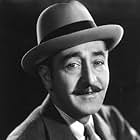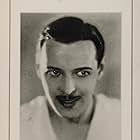Geoffrey, a young and impoverished writer, is desperately in love with Mavis, who lives at his boardinghouse and is also pursuing a writing career. Unable to marry her because of his poverty... Read allGeoffrey, a young and impoverished writer, is desperately in love with Mavis, who lives at his boardinghouse and is also pursuing a writing career. Unable to marry her because of his poverty, in his anger he curses God for abandoning him. Soon Geoffrey meets Prince Lucio de Riman... Read allGeoffrey, a young and impoverished writer, is desperately in love with Mavis, who lives at his boardinghouse and is also pursuing a writing career. Unable to marry her because of his poverty, in his anger he curses God for abandoning him. Soon Geoffrey meets Prince Lucio de Rimanez, a wealthy, urbane gentleman who informs Geoffrey that he has inherited a fortune, but ... Read all
- Awards
- 2 wins total
- Undetermined Secondary Role
- (as Jeanne Morgan)
- Undetermined Secondary Role
- (uncredited)
- Undetermined Secondary Role
- (uncredited)
- Undetermined Secondary Role
- (uncredited)
- Marriage Clerk
- (uncredited)
Storyline
Did you know
- TriviaFilm debut of Sylvia Sidney, who appears in an extra role as a bridesmaid.
- ConnectionsFeatured in The Love Goddesses (1965)
One would think that by the mid-1920s this sort of thing would look hopelessly dated as potential movie material, but somehow the brass at Paramount Pictures came to believe it would be the ideal assignment for their distinguished contract director, David Wark Griffith. Griffith, whose glory days were already past, had formerly been working independently and releasing his films through United Artists, which he co-founded, but he had lost his independence along with his New York studio for a number of reasons, including financial ineptitude and poor choice of material. More specifically, he had lost touch with his audience. Times were changing fast in the Roaring Twenties, and Griffith couldn't keep up. It's significant that the Paramount moguls believed this aging literary property would be just the thing for their aging director, who was himself something of a throwback to the Good Old Days.
So, Griffith adapted Corelli's Faust tale, updating the story once more to the present, and casting handsome Ricardo Cortez as struggling author Geoffrey Tempest, led astray by Adolphe Menjou's suave "Prince Lucio," i.e. Satan in disguise. As in Griffith's past half-dozen films the leading lady would be his girlfriend, Carol Dempster, a modestly talented and rather mousy-looking actress who was not widely appreciated. Cinema historians continue to puzzle over the director's dogged attempts to foist Miss Dempster onto the public. The film, at any rate, was not terribly expensive to make, especially after the Paramount brass vetoed a storm-at-sea climax, and Griffith appears to have made a concerted effort to affect a more 'modern' style. The results? The Sorrows of Satan was a flop which got Griffith fired from Paramount and drove Carol Dempster into permanent retirement.
Seen today, The Sorrows of Satan isn't all that bad, but it isn't all that good, either, and it's not hard to see why it failed on first release. The biggest problem by far is the film's frustratingly draggy pace: the opening scenes in particular are very, very, VERY slow. It takes a lot longer than it should to introduce our two leads and get the story rolling. Geoffrey Tempest (Cortez) and Mavis Claire (Dempster) are both struggling authors who live across the hall from each other in a shabby boarding house. When they go out together for a meal, it feels like their every gesture and expression is held a beat or so too long. When they decide to go get a marriage license, their every move is painstakingly (and unnecessarily) spelled out for the viewer. What's worse, we aren't given much reason to care about them. It feels like years before Adolphe Menjou's Prince Lucio shows up to tempt Geoffrey into sin, and frankly he's most welcome. Things do indeed pick up when Satan steps in -- Menjou is terrific in the role - - and we're treated to glimpses of decadent nightclub floor shows, and garden parties where guests are dressed as Nymphs and Satyrs. In short, Griffith makes like Cecil B. DeMille, and it's all very Twenties, but somehow the movie still doesn't quite click. We're kept at a distance from these characters, and just when things start to get interesting the camera pulls away, and the tempo slows down again.
The best sequence comes when Geoffrey, now wealthy but miserable, married to an exotic Russian princess in exile, wakes up in his Xanadu-like mansion sensing that something is wrong. His wife has cornered Prince Lucio in a drawing room downstairs, and is confessing that she married Geoffrey only to be near him (i.e Satan). Geoffrey creeps down the stairs and finds his wife throwing herself at Lucio's feet. It's a suspenseful, well-edited sequence, consisting of shadowy shots of the mansion which look creepy and menacing, and happily there are no intrusive title cards inserted to break up the rhythm.
But the ending is disappointingly flat, and we're left feeling deflated. The actors aren't to blame. Adolphe Menjou was ideally cast as the suave Lucio, and it's too bad he never played the role in a talkie. Ricardo Cortez has a nicely expressive face, and even Carol Dempster kind of grows on you after awhile (her washed-out, careworn appearance helps gains sympathy for the mistreated Mavis) but we are never given much reason to root for them. The director keeps us at a distance from the lead characters; perhaps he didn't care for the material much, himself. Griffith's Sorrows of Satan is an unusual and mildly diverting film -- that is, if you can get past the leaden opening scenes -- but general audiences, especially those unaccustomed to silent movies, would do just as well to skip it. Marie Corelli's novel is highly recommended, however: it's a hoot!
- How long is The Sorrows of Satan?Powered by Alexa
Details
Box office
- Budget
- $971,260 (estimated)
- Runtime1 hour 30 minutes
- Sound mix
- Aspect ratio
- 1.33 : 1
Contribute to this page


































